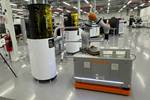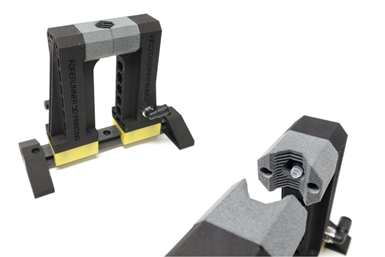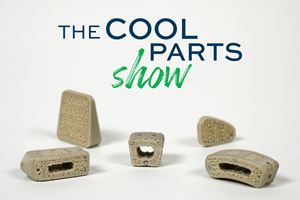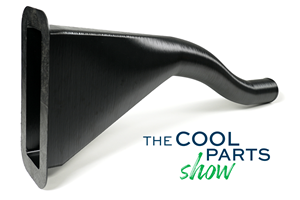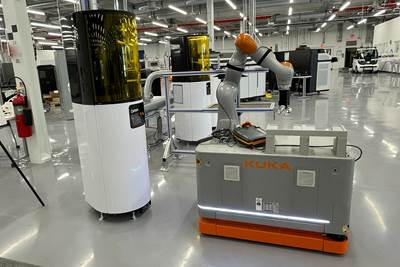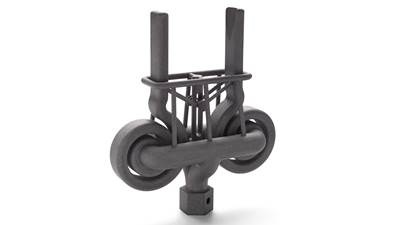Paul DeWys, founder and sales engineer at Forerunner 3D Printing LLC (Coopersville, Michigan) says he started his first company — an engineering design service called DeWys Engineering LLC — in his dorm room at Ferris State University in 2010 after working for a number of tool and die shops during summers before graduation. The design company grew over the next 6 years and developed a specialty in automation equipment, particularly additively manufactured components for injection molding operations — an area DeWys had found wanting when he worked in that segment.
“I grew up working in a lot of manufacturing facilities and automation was always something that interested me — especially robots,” DeWys explains. “Because of that, when I began staking my business position in the engineering world, I decided to focus on automation and tooling.” He notes that there are few places in industry where robots will be removed and replaced with humans over the next decade, as there are too few workers to meet current demand with the massive wave of baby boomer retirements. The only way for manufacturers to meet that demand, let alone grow, will be to add more automation. “We saw that the manufacturing industry was in desperate need of a 3D printing company that also was an expert in shopfloor manufacturing equipment, and we also saw that no one in the additive world was paying any attention to the manufacturing segment,” he adds.
Early on, DeWys Engineering designed additively manufactured end-of-arm tooling (EOAT) and fixtures, then sent them to a local service bureau to be produced. In 2016, DeWys had the opportunity to buy out his 3D printing vendor and bring AM in-house. That led to the creation of a separate custom printing division called Forerunner 3D, which produces parts designed by DeWys Engineering or by customers themselves.
In the intervening years, Forerunner has added a number of different polymer AM technologies to its offering, including Multi Jet Fusion (MJF) from HP Inc., Polyjet polymer jetting printers and fused deposition modeling/FDM (also called fused filament fabrication/FFF) from Stratasys, selective laser sintering (SLS) from EOS GmbH and stereolithography (SLA) from 3D Systems Inc..
This gives the company considerable flexibility in the types of parts it produces, including a broad range of EOATs, part pickers/grabbers, sandblasting masks, Pogo pin nests, vacuum forming tools, and even metal foundry pattern tools and machine assembly components for automation cells.
Shown above is a hybrid EOAT printed on a MultiJet Fusion (MJF) printer in polyamide 12 (PA12) used to remove eight ring-shaped parts from an injection mold. By combining conventional and additive components, a lighter, more efficient automation tool can be produced faster and at less cost. Photo Credit: Forerunner 3D Printing LLC
Currently, 95% of the company’s printed EOAT are produced on MJF printers in polyamide 12 (PA12). For especially large parts, the company often adds brass heat-set inserts for threaded connections, which are installed as a post-print secondary operation. Rather than develop monolithic designs, most EOAT are produced as multicomponent builds to provide adjustability and are subsequently snap-fit together or are mechanically joined or adhesively bonded. Many part pickers are overprinted with thermoplastic polyurethane (TPU) elastomeric grips in secondary operations to protect the integrity of aesthetic parts with sensitive finishes. It’s also common to produce hybrid EOAT featuring tubular components or jig plates in 80/20 aluminum that are connected to a printed vacuum gripper nest with integral vacuum channels (printed much like conformal cooling channels are in metal AM mold inserts). Typical customers are injection molders and moldmaking shops, although DeWys and Forerunner also work with machine builders and robot integrators.
An example of a hybrid automation part designed by DeWys Engineering and produced by Forerunner 3D is this EOAT, which was printed via MJF in PA12 with TPU gripper pads. The device is mounted to a six-axis robot and used to grab parts with aesthetic finishes for the consumer goods industry as they are ejected from an injection mold. Each gripper finger has a vacuum line routed through it and uses a suction cup (buried in the TPU gripper pad) to make sure it has full contact with the part as long as the robot is holding it. Photo Credit Forerunner 3D Printing LLC
DeWys acknowledges that getting manufacturers to try AM technology requires education and patience, and says he conducts a lot of “lunch-and-learns” to educate companies on what DeWys and Forerunner can do, the lessons they’ve learned and how the company can make automation components faster, lighter and at lower cost than companies can produce themselves or buy from conventional manufacturers.
“Circa 2016 to 2019, we’d try to get manufacturers interested in adding a few cobots [collaborative robots] and they’d tell us that they didn’t need automation because Bob the Box Stacker had worked for them for 40 years,” DeWys adds. “Now fast forward to the pandemic and its crazy labor shortages and our phones were ringing off the hook for a solid year. All of a sudden, Bob the Box Stacker was gone and there was nobody they could hire to stack boxes anymore. In the past 2 years, we’ve been absolutely inundated with automation jobs.”
What advice does he have for those considering additively produced automation components? “AM is just one more tool in your toolbox and I’m not here to put your CNC department out of business — what I offer is a supplement to your CNC department that will enable you to produce things you couldn’t make otherwise,” DeWys says. “Also, don’t feel like you have to print your entire EOAT. Make the structure out of 80/20 and then you have the design freedom and rapid turnaround that only additive can provide. The hybrid approach is not only lighter and less costly, but it’s adjustable in a way that metal alone is not.”
More From This Author
Peggy Malnati is a Detroit-based contributing writer for CompositesWorld magazine, for which she primarily reports on automotive and ground transportation. SUBSCRIBE HERE
Related Content
FDA-Approved Spine Implant Made with PEEK: The Cool Parts Show #63
Curiteva now manufactures these cervical spine implants using an unusual 3D printing method: fused strand deposition. Learn how the process works and why it’s a good pairing with PEEK in this episode of The Cool Parts Show.
Read MoreAircraft Ducts 3D Printed in Composite Instead of Metal: The Cool Parts Show #68
Eaton’s new reinforced PEKK, tailored to aircraft applications, provides a cheaper and faster way to make ducts compared to formed aluminum.
Read More3D Printed Spine Implants Made From PEEK Now in Production
Medical device manufacturer Curiteva is producing two families of spinal implants using a proprietary process for 3D printing porous polyether ether ketone (PEEK).
Read MoreCopper, New Metal Printing Processes, Upgrades Based on Software and More from Formnext 2023: AM Radio #46
Formnext 2023 showed that additive manufacturing may be maturing, but it is certainly not stagnant. In this episode, we dive into observations around technology enhancements, new processes and materials, robots, sustainability and more trends from the show.
Read MoreRead Next
Autonomous Cobot Automation Increases Production 3D Printer Output for Ford (Includes Video)
A mobile robot that travels to each Carbon machine to unload builds lets the automaker run an additional three to four builds per machine per day. Autonomous robots fit well with 3D printing, but their role in production will extend beyond just the additive machines.
Read MoreOne-Piece Robot Gripper Actuated by Shop Air
The pneumatic gripper 3D-printed as a complete working unit has demonstrated its effectiveness for continuous operation over time. It is one illustration of the role additive is liable to play in making robotic automation easier.
Read More3D Printed End of Arm Tooling Aids Automation
Frustrations with traditional end of arm tooling led Richard Savage to start 3D printing custom versions for injection molding applications, eventually founding a company to fill this niche.
Read More

.jpg;width=70;height=70;mode=crop)
